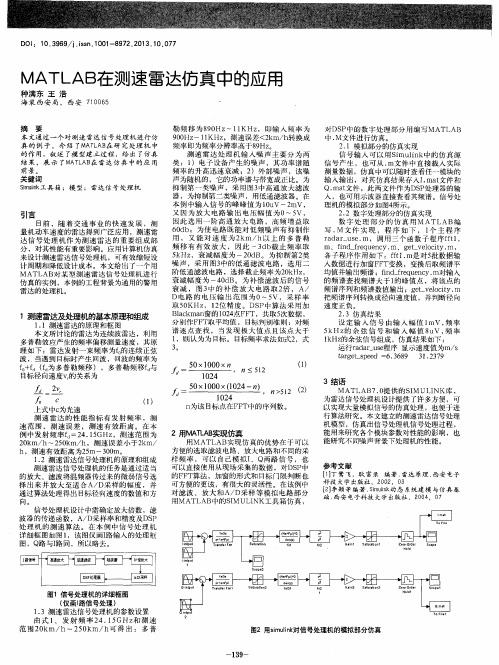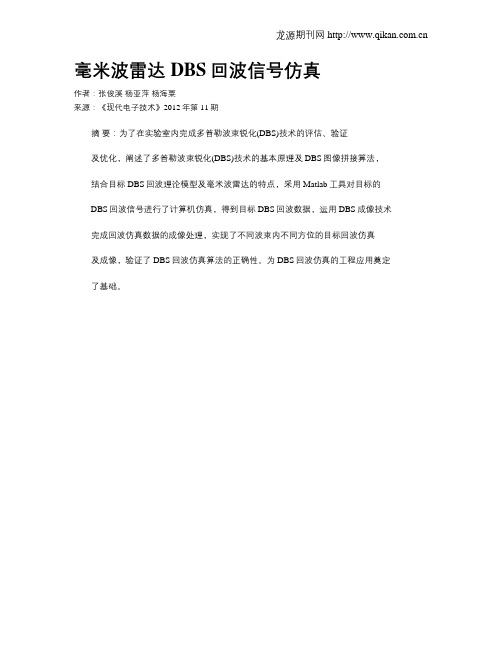Matlab雷达回波数据模拟
MATLAB在测速雷达仿真中的应用

勒频移为8 9 0 HZ ~1 1 KHZ ,即 输 入 频 率 为 对D S P中的 数 字处 理 部 分 用编 写M A TL At 3 9 0 0 Hz ~1 1 K Hz ,测 速误 差 < 2 k m/ h 转换 成 中 . M文件 进行 仿真 。 频 率 即为频 率分 辨率 高 于8 9 Hz 。 2 . 1模拟部 分 的仿真 实 现 测 速 雷 达 处 理 机输 入 噪 声 主 要 分 为 两 信 号 输 入 可 以 用S i mu l i n k 中 的仿 真 源 类 :1 )电子 设 备 产 生 的噪 声 ,其功 率 谱 随 信 号 产 生 ,也 可 从 . i n 文件 中直 接 载入 实际 频 率 的升 高 迅 速衰 减 ;2 )9 1 、 部 噪声 ,该 噪 测 量数据 ,仿真 中可 以随 时查 看任 一模块 的 声为 随机 的 ,它 的功 率谱 与带 宽成 正 比。 为 输 入输 出 ,对其 仿 真结 果 存入 I . ma t 文件 和 抑制 第 一 类噪 声 ,采 用 图3 中高通 放 大 滤波 Q. ma t 文 件 ,此 两文 件作 为D S P 处理 器 的输 器 ,为抑 制第 二 类噪 声 ,用低 通滤 波 器 。在 入 ,也 可用 示波 器直 接查 看其频 谱 。信 号处 本 例 中输 入信 号 的峰 峰 值 为 1 0 u V~2 mV, 理 机的模 拟 部分 如 图4 所示 。 又 因 为 放 大 电路 输 出 电压 幅 值 为 0 ~5 V, 2 . 2 数 字处理 部分 的仿 真实 现 因 此 选 用 一 阶 高 通 放 大 电路 ,高 频 增 益 取 数 字 处 理 部 分 的 仿 真 用 M ATL AB编 6 0 d b;为使 电路 既 能 对 低 频 噪 声 有 抑制 作 写 . M 文 件 实 现 ,程 序 如 下 , 1 个 主 程 序 用 ,又能对 速度 为2 k m/ h以 上 的 多 普 勒 r a dar u s e . m ,调 用 三 个 函数 子 程 序 ft 1 . i nd f r e que nc y. i 2 2 、 ge t ve l o c i t y. 1 T I , 频 移 有 有 效 放 大 , 因此 ~3 d b 截 止 频 率 取 m 、 f 5 k Hz ,衰 减 幅 度 为 一2 0 d B。为 抑 制 第 2 类 各子 程 序 作 用 如下 :f i t 1 . I I 1 是对5 批 数 据输 噪 声 ,采 用 图3 中 的低 通滤 波 电路 ,选 用 二 入数 据进 行加 窗F F T 变换 ,变换后 取频 谱平 阶低 通滤 波 电路 ,选 择截 止频 率 为2 0 k Hz , 均值 并输 出频 谱 ;f i n d _ f r e q u e n c y . 1 T I 对 输 人 衰 减 幅 度 为 一4 0 d B。为 补 偿 滤 波后 的信 号 的频 谱 查 找频 谱 大 干 1 的峰 值 点 ,将 该 点 的 衰 减 , 图3 中 的 补 偿放 大 电路 取 2 倍 , A/ 频谱 序 列和 频谱 数值 输 出 ;g e t — v e l o c i t y. m D电路 的 电压 输 出 范 围 为 O ~5 V,采 样 率 把 频谱 序 列转换 成径 向速度 值 ,并 判断 径 向 取5 O KHZ ,1 2 位 精 度 。D S P中算 法 采 用 加 速度正 负 。 B l a c k ma n 窗的1 0 2 4 点F F T,共取 5 次 数据 , 2 . 3 仿真 结果 分 别作 F F T 取平 均值 , 目标 判别 准则 :对 频 设 定 输 人 信 号 由输 入 幅 值 1 mV, 频 率 谱 逐 点查 找 , 当 发 现 极 大 值 点 且 该 点 大 干 5 k HZ 的余 弦信 号 和输 入幅 值8 u V, 频 率 1 ,则认 为 为 目 标 。 目标 频率 求法 如 式2 ,式 l k Hz 的余 弦信 号组 成 ,仿真结 果如 下 : 3。 运 行r a d a r — u s e 程序 显示 速 度值为 m/ s
毫米波雷达DBS回波信号仿真

龙源期刊网
毫米波雷达DBS回波信号仿真
作者:张俊溪杨亚萍杨海粟
来源:《现代电子技术》2012年第11期
摘要:为了在实验室内完成多普勒波束锐化(DBS)技术的评估、验证
及优化,阐述了多普勒波束锐化(DBS)技术的基本原理及DBS图像拼接算法,
结合目标DBS回波理论模型及毫米波雷达的特点,采用Matlab工具对目标的
DBS回波信号进行了计算机仿真,得到目标DBS回波数据,运用DBS成像技术
完成回波仿真数据的成像处理,实现了不同波束内不同方位的目标回波仿真
及成像,验证了DBS回波仿真算法的正确性。
为DBS回波仿真的工程应用奠定
了基础。
matlab回波延时

在MATLAB中,可以使用以下方法计算回波信号的延时:1. 首先,需要生成一个回波信号,可以使用freqresp 函数或者sinewave 函数来生成。
2. 然后,需要计算信号在传输过程中的延时,可以使用trapz 函数来计算信号的时间加权延迟。
具体来说,需要设置信号的起始时间和结束时间,以及信号的幅度和相位,然后使用trapz 函数计算信号在传输过程中的加权延迟。
3. 最后,需要将信号的起始时间向前移动相应的时间延迟,即可得到回波信号的延时版本。
以下是一个示例代码,用于计算信号在传输过程中的加权延迟:生成回波信号fs = 1000; 采样率t = 0:1/fs:(1-1/fs); 时间向量f = 10; 信号频率A = 0.5; 信号幅度phase = pi/2; 相位y = sin(2*pi*f*t).*A.*cos(phase); 回波信号计算加权延迟t = linspace(0,1,length(y)); 时间向量y_delayed = zeros(length(y),1); 存储加权延迟后的信号for i = 1:length(y)y_delayed(i) = y(i)*t(i)/(1+t(i).^2); 计算加权延迟end绘制原始信号和加权延迟后的信号figure;subplot(2,1,1);plot(t,y);title('原始信号');subplot(2,1,2);plot(t,y_delayed);title('加权延迟后的信号');在这个示例中,首先生成了一个频率为10 Hz、幅度为0.5的正弦波信号,然后计算了信号在传输过程中的加权延迟,并将信号向前移动相应的时间延迟,得到了加权延迟后的信号。
最后,使用subplot 函数将原始信号和加权延迟后的信号绘制在同一个图形窗口中,以便进行比较。
在Matlab中进行雷达信号处理和目标跟踪

在Matlab中进行雷达信号处理和目标跟踪雷达信号处理和目标跟踪是现代雷达技术的重要组成部分,在军事、航空、航天、气象等领域中具有广泛的应用。
Matlab作为一种功能强大的数学软件工具,为雷达信号处理和目标跟踪提供了便利的开发环境。
本文将介绍如何利用Matlab 进行雷达信号处理和目标跟踪,并探讨一些常用的算法和技术。
首先,我们需要了解雷达信号处理的基本概念和流程。
雷达信号处理包括信号预处理、目标检测、目标定位和跟踪等步骤。
在Matlab中,我们可以利用其丰富的工具箱和函数实现这些步骤。
例如,通过使用信号处理工具箱中的函数,我们可以对雷达信号进行滤波、解调、去噪等预处理操作;而通过使用图像处理工具箱中的函数,我们可以实现雷达信号的目标检测和定位。
此外,Matlab还提供了强大的图形界面和数据可视化工具,使我们能够直观地显示和分析雷达信号。
接下来,让我们具体介绍一些常用的雷达信号处理算法和技术。
其中之一是自适应抗干扰处理技术。
雷达系统在实际应用中可能会受到各种干扰,如天线旁瓶、气象杂波等。
自适应抗干扰技术能够根据实时环境自动调整各种参数,提高雷达系统的抗干扰性能。
在Matlab中,我们可以使用自适应滤波器函数对雷达信号进行抗干扰处理。
另一个常用的算法是脉冲压缩处理。
脉冲压缩是一种通过延长脉冲宽度来提高雷达目标分辨率的方法。
在Matlab中,我们可以利用FFT(快速傅里叶变换)等函数对雷达信号进行压缩处理,从而减小脉冲宽度,提高目标分辨率。
除了雷达信号处理,目标跟踪也是雷达应用中的重要环节。
目标跟踪旨在实时追踪目标的位置和运动状态。
在Matlab中,我们可以使用一些常见的目标跟踪算法,如卡尔曼滤波器和粒子滤波器。
这些算法能够根据目标的先验信息和测量值,精确估计目标的位置和动态特性,并实现目标的实时跟踪。
除了以上提到的算法和技术,Matlab还提供了许多其他功能强大的工具和函数,如多普勒失真校正、雷达图像生成、目标特征提取等。
雷达接收机的MATLAB仿真

利用最长延时估计频率
利用所有相关器的相位输出 时对频率进行最小二乘估计
西安电子科技大学
仿真结果:
基于多路鉴相器的并行运用
西安电子科技大学
信道化接收机MATLAB举例
%>>>>>>>>>>适用于三级结构>>>>>>>>>>>>>> clc;clear; f1=2000;f2=4000;%测频范围 f=input('输入待测频率 (MHz) '); if f>=f1&&f<=f2 m1=4;m2=4;m3=4;%各分路器均设为5,分路器结构 u=(f2-f1)/(m1*m2*m3);%频率分辨力 ur=[0,0,0];%为各分路器中放带宽提供缓存
西安电子科技大学
num=zeros(1,3);%为每层的信道提供缓存 for k=1:3 j=1; while j<=4 if f-fl(k,j)>=fi(k)-ur(k)/2&&f-fl(k,j)<=fi(k)+ur(k)/2 f=f-fl(k,j); num(k)=j-1; break; else j=j+1; end 频率估计公式 end end
因为,你不在身边 。
快乐时,感到微微的惶恐。 大笑时,感到莫名的忧伤。
初遇你的那天,整个世界都被点亮。 回忆里你的笑容,如那午夜温柔的月光。 于是我时常微笑,因为在你面前没有权利悲伤。
岁月漂白了时光, 这一切也只不过是我单纯的盼望。 多想在阴雨时为你撑起伞, 多想在危难时化为一堵墙。
但这零碎的幸福,却是那阳光的方向。 我可以做你的骑士吗? 为你,击碎人生所有的无常。
雷达信号处理和数据处理(业界借鉴)

脉冲压缩雷达的仿真脉冲压缩雷达与匹配滤波的MATLAB仿真姓名:--------学号:----------2014-10-28西安电子科技大学信息对抗技术一、 雷达工作原理雷达,是英文Radar 的音译,源于radio detection and ranging 的缩写,原意为"无线电探测和测距",即用无线电的方法发现目标并测定它们的空间位置。
因此,雷达也被称为“无线电定位”。
利用电磁波探测目标的电子设备。
发射电磁波对目标进行照射并接收其回波,由此获得目标至电磁波发射点的距离、距离变化率(径向速度)、方位、高度等信息。
雷达发射机的任务是产生符合要求的雷达波形(Radar Waveform ),然后经馈线和收发开关由发射天线辐射出去,遇到目标后,电磁波一部分反射,经接收天线和收发开关由接收机接收,对雷达回波信号做适当的处理就可以获知目标的相关信息。
但是因为普通脉冲在雷达作用距离与距离分辨率上存在自我矛盾,为了解决这个矛盾,我们采用脉冲压缩技术,即使用线性调频信号。
二、 线性调频(LFM )信号脉冲压缩雷达能同时提高雷达的作用距离和距离分辨率。
这种体制采用宽脉冲发射以提高发射的平均功率,保证足够大的作用距离;而接受时采用相应的脉冲压缩算法获得窄脉冲,以提高距离分辨率,较好的解决雷达作用距离与距离分辨率之间的矛盾。
脉冲压缩雷达最常见的调制信号是线性调频(Linear Frequency Modulation )信号,接收时采用匹配滤波器(Matched Filter )压缩脉冲。
LFM 信号的数学表达式:(2.1)其中c f 为载波频率,()t rect T为矩形信号:(2.2)其中BKT=是调频斜率,信号的瞬时频率为()22cT Tf Kt t+ -≤≤,如图(图2.1.典型的LFM信号(a)up-LFM(K>0)(b)down-LFM(K<0))将式1改写为:(2.3)其中(2.4)是信号s(t)的复包络。
相控阵雷达 matlab
相控阵雷达 matlab一、相控阵雷达的概念和原理相控阵雷达(Phased Array Radar)是一种基于微波电路技术的雷达系统,它通过控制天线阵列中每个单元的发射和接收信号时序和幅度,实现对目标的定位、跟踪和识别。
相比传统的机械扫描雷达,相控阵雷达具有扫描速度快、灵活性高、抗干扰能力强等优点。
相控阵雷达的原理是基于波束形成技术,即将多个天线单元组合成一个虚拟天线,通过改变各个天线单元之间的相位差来实现波束方向和宽度的调节。
这样可以实现对目标在不同方向上进行扫描和跟踪。
二、Matlab在相控阵雷达中的应用Matlab是一种强大的数学计算软件,在相控阵雷达领域也有广泛应用。
以下是Matlab在相控阵雷达中常见应用场景:1. 相控阵天线设计Matlab可以辅助进行天线设计,包括天线单元数量、间距、位置等参数的确定。
同时还可以进行电磁仿真分析,验证天线的性能和可行性。
2. 波束形成算法Matlab可以实现各种波束形成算法,包括传统的波束形成方法和自适应波束形成方法。
通过模拟实验,可以比较不同算法的性能和适用范围。
3. 目标检测与跟踪Matlab可以进行目标检测和跟踪,根据雷达接收到的信号数据,利用信号处理技术实现对目标的识别和跟踪。
同时还可以进行仿真模拟,验证算法的准确性和可靠性。
4. 仿真模拟Matlab可以进行相控阵雷达系统的仿真模拟,包括天线阵列、信号处理、目标模型等多个方面。
通过仿真模拟,可以评估系统性能、优化参数设置等。
三、相控阵雷达系统设计流程相控阵雷达系统设计流程一般包括以下几个步骤:1. 系统需求分析在设计相控阵雷达系统前,需要明确系统需求和指标要求。
包括工作频段、扫描范围、分辨率、灵敏度等参数。
2. 天线设计根据系统需求确定天线单元数量、间距、位置等参数,进行天线阵列的设计和优化。
3. 信号处理算法选择与优化根据系统需求和目标特点,选择合适的波束形成算法和信号处理算法,并进行优化。
SAR成像RD算法MATLAB仿真
SAR成像RD算法MATLAB仿真在雷达成像中,SAR(Synthetic Aperture Radar)是一种通过向地面发射微波信号并接收反射回来的信号,来生成高分辨率地面图像的技术。
而RD(Range Doppler)算法是一种常用的SAR成像算法,用于将获得的原始数据处理成可视化的图像。
MATLAB是一种在科学和工程领域广泛使用的数学软件,具有强大的矩阵运算和图像处理功能。
下面将介绍如何使用MATLAB进行SAR成像的RD算法仿真。
首先,需要生成模拟的SAR返回信号。
可以使用MATLAB的信号处理工具箱中的函数进行模拟。
假设我们使用一个长度为N的脉冲信号进行雷达扫描,在SAR成像中,我们通常使用线性调频(Linear Frequency Modulation)信号。
可以使用MATLAB的`chirp`函数生成一个线性调频信号。
```matlabN=1024;%信号长度T=5e-6;%信号周期,信号的时间长度为T*Nfs = 100e6; % 采样频率f0=0;%初始频率f1=10e6;%终止频率t = 0:1/fs:T*N-1/fs;s = chirp(t, f0, T*N, f1);```接下来,我们需要生成一个代表地物散射特性的复数反射系数矩阵。
假设地面上有一个半径为R的圆形散射体,其反射系数为0.8、可以使用MATLAB的`meshgrid`函数生成一个二维的坐标网格,然后使用`sqrt`函数计算每个网格点到原点的距离。
```matlabR=5;%圆形散射体半径Np=100;%地物散射点个数x = linspace(-R, R, Np);y = linspace(-R, R, Np);[X, Y] = meshgrid(x, y);rho = sqrt(X.^2 + Y.^2); % 距离计算```然后,我们可以根据雷达与地物之间的距离计算相位偏移。
根据SAR 成像的原理,SAR返回信号中的每个采样点都对应着不同距离下的散射信号。
多普勒雷达仿真代码
多普勒雷达仿真代码下面是一个简单的多普勒雷达仿真代码的示例,使用 Python 编写。
这个示例代码模拟了多普勒雷达的基本工作原理,并生成了一些模拟的雷达回波数据。
```pythonimport numpy as npimport matplotlib.pyplot as plt# 定义多普勒雷达的参数c = 3e8 # 光速(m/s)f = 1e9 # 雷达频率(Hz)v = 300 # 目标速度(m/s)theta = np.radians(30) # 雷达波束与目标速度之间的夹角# 生成时间序列t = np.linspace(0, 2 * np.sqrt(v**2 * np.sin(theta)**2 / (2 * c * f)), 1000) # 计算多普勒频移fd = 2 * v * np.sin(theta) * np.cos(2 * np.pi * f * t / c)# 生成模拟的雷达回波数据echo = np.sin(2 * np.pi * f * t + fd)# 绘制结果plt.plot(t, echo)plt.xlabel('Time (s)')plt.ylabel('Amplitude')plt.title('Doppler Radar Simulation')plt.show()```在这个示例代码中,我们首先定义了一些多普勒雷达的参数,包括光速`c`、雷达频率`f`、目标速度`v`和雷达波束与目标速度之间的夹角`theta`。
然后,我们生成了一个时间序列`t`,表示雷达发射和接收信号的时间。
接下来,我们根据多普勒效应的公式计算了多普勒频移`fd`,并生成了模拟的雷达回波数据`echo`。
在这里,我们使用了一个简单的正弦函数来模拟回波信号的形状。
最后,我们使用`matplotlib`绘制了结果,显示了时间`t`和回波信号`echo`的关系图。
毫米波雷达三坐标matlab
毫米波雷达三坐标matlab介绍毫米波雷达是一种利用毫米波频段进行探测和成像的雷达系统。
它具有高分辨率、抗干扰能力强等优点,被广泛应用于机场安全、车辆自动驾驶、人体成像等领域。
三坐标毫米波雷达是一种可以同时获取目标的距离、速度和角度信息的雷达系统,它可以实现对目标的精准定位和跟踪。
本文将介绍如何使用Matlab对三坐标毫米波雷达进行数据处理和分析。
数据获取三坐标毫米波雷达通常由发射天线、接收天线和信号处理系统组成。
在实验中,我们可以使用一个仿真平台来模拟雷达系统的工作过程。
Matlab提供了一个名为Phased Array System Toolbox的工具箱,它可以用于设计、分析和模拟天线阵列和雷达系统。
我们可以使用这个工具箱来生成毫米波雷达的信号和接收数据。
首先,我们需要定义雷达系统的参数,包括发射频率、接收天线的位置和方向、目标距离和速度等。
然后,我们可以使用phased.LinearFMWaveform函数生成线性调频信号,该函数可以指定信号的中心频率、带宽和脉冲宽度等参数。
接下来,我们可以使用phased.Transmitter和phased.Receiver对象来模拟发射和接收天线。
这些对象可以指定天线的位置、方向和增益等参数。
最后,我们可以使用phased.RadarTarget对象来模拟目标,并将其放置在指定的距离和速度处。
该对象可以指定目标的反射系数和散射特性等参数。
数据处理一旦我们生成了雷达信号和接收数据,我们就可以使用Matlab进行数据处理和分析。
首先,我们需要将接收数据进行FFT变换,以获得频域信息。
然后,我们可以使用信号处理技术来提取目标的距离、速度和角度信息。
以下是一些常用的信号处理技术:1. 距离测量:我们可以使用峰值检测算法来提取目标的距离信息。
该算法可以搜索FFT谱中的峰值,并计算对应的距离值。
2. 速度测量:我们可以使用多普勒处理技术来提取目标的速度信息。
该技术可以将接收信号进行FFT变换,并提取多普勒频移。
- 1、下载文档前请自行甄别文档内容的完整性,平台不提供额外的编辑、内容补充、找答案等附加服务。
- 2、"仅部分预览"的文档,不可在线预览部分如存在完整性等问题,可反馈申请退款(可完整预览的文档不适用该条件!)。
- 3、如文档侵犯您的权益,请联系客服反馈,我们会尽快为您处理(人工客服工作时间:9:00-18:30)。
clear, hold off format compact J = sqrt(-1); close all% Get root file name for saving resultsfile=input('Enter root file name for data and listing files: ','s');
% form radar chirp pulseT = 10e-6; % pulse length, seconds W = 10e6; % chirp bandwidth, Hz fs = 12e6; % chirp sampling rate, Hz; oversample by a littlefprintf('\nPulse length = %g microseconds\n',T/1e-6) fprintf('Chirp bandwidth = %g Mhz\n',W/1e6) fprintf('Sampling rate = %g Msamples/sec\n',fs/1e6) s = git_chirp(T,W,fs/W); % 120-by-1 array plot((1e6/fs)*(0:length(s)-1),[real(s) imag(s)]) title('Real and Imaginary Parts of Chirp Pulse') xlabel('time (usec)') ylabel('amplitude') gridNp = 20; % 20 pulses jkl = 0:(Np-1); % pulse index array, 慢时间采样的序列,注意第一个PRI标记为0是为了慢时间起始时刻从零开始 PRF = 10.0e3; % PRF in Hz PRI = (1/PRF); % PRI in sec T_0 = PRI*jkl; % relative start times of pulses, in sec g = ones(1,Np); % gains of pulses T_out = [12 40]*1e-6; % start and end times of range window in sec, 这个就是接收窗的时间宽度Trec T_ref = 0; % system reference time in usec, T_ref = 0指T_0=0时,r_at_T_0 = ri ;当T_0 ~= 0时,r_at_T_0 = ri - vi*T_0(j)fc = 10e9; % RF frequency in Hz; 10 GHz is X-bandfprintf('\nWe are simulating %g pulses at an RF of %g GHz',Np,fc/1e9) fprintf('\nand a PRF of %g kHz, giving a PRI of %g usec.',PRF/1e3,PRI/1e-6) fprintf('\nThe range window limits are %g to %g usec.\n', ... T_out(1)/1e-6,T_out(2)/1e-6)% Compute unambiguous Doppler interval in m/sec % Compute unambiguous range interval in metersvua = 3e8*PRF/(2*fc); %第一盲速 rmin = 3e8*T_out(1)/2; rmax = 3e8*T_out(2)/2; rua = 3e8/2/PRF;fprintf('\nThe unambiguous velocity interval is %g m/s.',vua) fprintf('\nThe range window starts at %g km.',rmin/1e3) fprintf('\nThe range window ends at %g km.',rmax/1e3) fprintf('\nThe unambiguous range interval is %g km.\n\n',rua/1e3)% Define number of targets, then range, SNR, and % radial velocity of each. The SNR will be the actual SNR of the target in % the final data; it will not be altered by relative range.Ntargets = 4; del_R = (3e8/2)*( 1/fs )/1e3; % in km ranges = [2 3.8 4.4 4.4]*1e3; % in km SNR = [-3 5 10 7]; % dB vels = [-0.4 -0.2 0.2 0.4]*vua; % in m/sec% From SNR, we compute relative RCS using the idea that SNR is proportional % to RCS/R^4. Students will be asked to deduce relative RCS. rel_RCS = (10.^(SNR/10)).*(ranges.^4); rel_RCS = db(rel_RCS/max(rel_RCS),'power')
fprintf('\nThere are %g targets with the following parameters:',Ntargets) for i = 1:Ntargets fprintf('\n range=%5.2g km, SNR=%7.3g dB, rel_RCS=%7.3g dB, vel=%9.4g m/s', ... ranges(i)/1e3,SNR(i),rel_RCS(i),vels(i) ) end% Now form the range bin - pulse number data mapdisp(' ') disp(' ') disp('... forming signal component') y = radar(s,fs,T_0,g,T_out,T_ref,fc,ranges,SNR,vels); % y是337-by-20的矩阵% add thermal noise with unit powerdisp('... adding noise') %randn('seed',77348911); [My,Ny] = size(y); nzz = (1/sqrt(2))*(randn(My,Ny) + J*randn(My,Ny)); % 产生方差为1的复高斯白噪声 y = y + nzz;% create log-normal (ground) "clutter" with specified C/N and 具体原理不清楚,需要时套用此格式即可! % log-normal standard deviation for amplitude, uniform phase % Clutter is uncorrelated in range, fully correlated in pulse #disp('... creating clutter') CN = 20; % clutter-to-noise ratio in first bin (dB) SDxdB = 3; % in dB (this is NOT the sigma of the complete clutter) ncc=10 .^((SDxdB*randn(My,Ny))/10); ncc = ncc.*exp( J*2*pi*rand(My,Ny) );% Force the power spectrum shape to be Gaussiandisp('... correlating and adding clutter') G = exp(-(0:4)'.^2/1.0); G = [G;zeros(Ny-2*length(G)+1,1);G(length(G):-1:2)];for i=1:My ncc(i,:)=ifft(G'.*fft(ncc(i,:))); end
% rescale clutter to have desired C/N ratio pcc = var(ncc(:)); ncc = sqrt((10^(CN/10))/pcc)*ncc; % 10*log10(var(ncc(:))/var(nzz(:))) % check actual C/N% Now weight the clutter power in range for assume R^2 (beam-limited) loss cweight = T_out(1)*((T_out(1) + (0:My-1)'*(1/fs)).^(-1)); cweight = cweight*ones(1,Np); ncc = ncc.*cweight; % var(ncc)可以看出20列clutter的方差均在30左右y = y + ncc;[My,Ny]=size(y); d=(3e8/2)*((0:My-1)*(1/fs) + T_out(1))/1e3; % T_out(1))/1e3是接收窗的起始时刻 plot(d,db(y,'voltage')) xlabel('distance (km)') ylabel('amplitude (dB)') grid% Save the data matrix in specified file. % Save the student version in the mystery file. % Also save all parameter value displays in corresponding filedata_file=[file,'.mat']; mystery_file=[file,'_mys.mat']; listing_file=[file,'.lis'];eval(['save ',data_file,' J T W fs s Np PRF PRI T_out fc vua', ... ' rmin rmax rua Ntargets ranges vels SNR rel_RCS y']);eval(['save -v6 ',mystery_file,' J T W fs s Np PRF T_out fc y']);fid=fopen(listing_file,'w');fprintf(fid,['\rDESCRIPTION OF DATA IN FILE ',file,'.mat AND ',file,'_mys.mat\r\r']); fprintf(fid,'\rPulse length = %g microseconds\r',T/1e-6); fprintf(fid,'Chirp bandwidth = %g Mhz\r',W/1e6); fprintf(fid,'Sampling rate = %g Msamples/sec\r',fs/1e6); fprintf(fid,'\rWe are simulating %g pulses at an RF of %g GHz',Np,fc/1e9); fprintf(fid,'\rand a PRF of %g kHz, giving a PRI of %g usec.',PRF/1e3,PRI/1e-6); fprintf(fid,'\rThe range window limits are %g to %g usec.\r', ... T_out(1)/1e-6,T_out(2)/1e-6); fprintf(fid,'\rThe unambiguous velocity interval is %g m/s.',vua); fprintf(fid,'\rThe range window starts at %g km.',rmin/1e3); fprintf(fid,'\rThe range window ends at %g km.',rmax/1e3); fprintf(fid,'\rThe unambiguous range interval is %g km.\r\r',rua/1e3); fprintf(fid,'\rThere are %g targets with the following parameters:', ... Ntargets); for i = 1:Ntargets fprintf(fid,'\r range=%5.2g km, SNR=%7.3g dB, rel_RCS=%7.3g dB, vel=%9.4g m/s', ... ranges(i)/1e3,SNR(i),rel_RCS(i),vels(i) ); endfclose(fid);fprintf(['\n\nData is in file ',data_file]) fprintf(['\nStudent data is in file ',mystery_file]) fprintf(['\nListing is in file ',listing_file,'\n\n']) _________________________________________________________________________用到的函数function y = radar( x, fs, T_0, g, T_out, T_ref, fc, r, snr, v ) % RADAR simulate radar returns from a single pulse or burst % of identical pulses % usage: % R = radar( X, Fs, T_0, G, T_out, T_ref, Fc, R, SNR, V ) % X: baseband single pulse waveform (complex vector) % Fs: sampling frequency of input pulse [in Hz] % T_0: start time(s) of input pulse(s) [sec]
